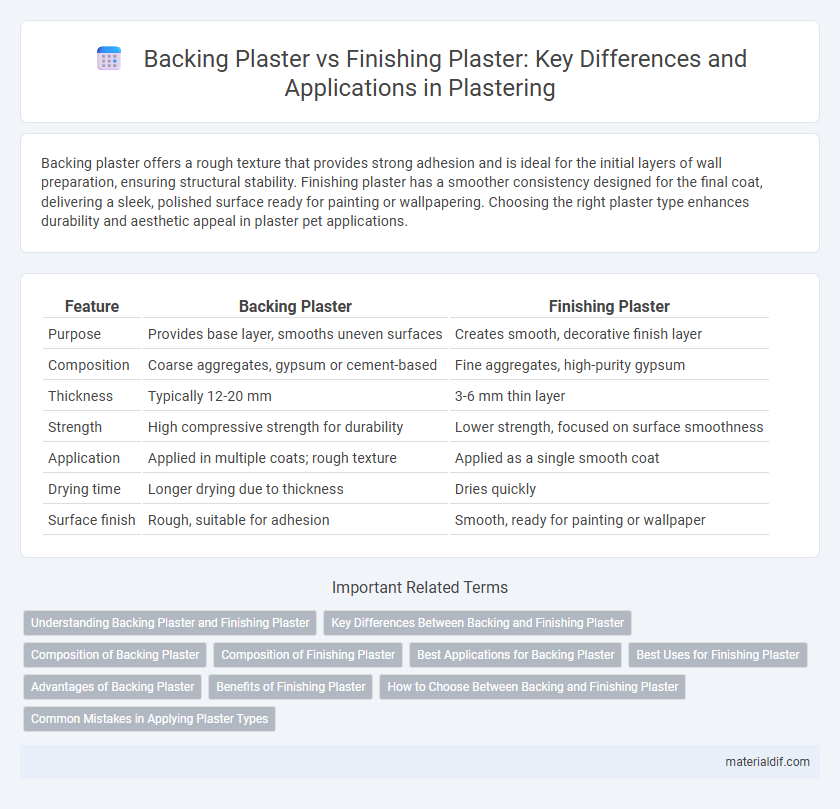Backing plaster offers a rough texture that provides strong adhesion and is ideal for the initial layers of wall preparation, ensuring structural stability. Finishing plaster has a smoother consistency designed for the final coat, delivering a sleek, polished surface ready for painting or wallpapering. Choosing the right plaster type enhances durability and aesthetic appeal in plaster pet applications.
Table of Comparison
| Feature | Backing Plaster | Finishing Plaster |
|---|---|---|
| Purpose | Provides base layer, smooths uneven surfaces | Creates smooth, decorative finish layer |
| Composition | Coarse aggregates, gypsum or cement-based | Fine aggregates, high-purity gypsum |
| Thickness | Typically 12-20 mm | 3-6 mm thin layer |
| Strength | High compressive strength for durability | Lower strength, focused on surface smoothness |
| Application | Applied in multiple coats; rough texture | Applied as a single smooth coat |
| Drying time | Longer drying due to thickness | Dries quickly |
| Surface finish | Rough, suitable for adhesion | Smooth, ready for painting or wallpaper |
Understanding Backing Plaster and Finishing Plaster
Backing plaster provides a strong, durable base layer that helps even out surfaces and enhances structural integrity in wall construction. Finishing plaster, applied as a thin topcoat, creates a smooth, aesthetically pleasing surface ideal for painting or wallpapering. Both types play crucial roles in plasterwork by ensuring durability and visual quality in interior walls.
Key Differences Between Backing and Finishing Plaster
Backing plaster is primarily used as a base coat due to its thicker consistency and faster drying time, providing strong support for subsequent layers. Finishing plaster, characterized by a finer texture and slower drying process, is formulated to create a smooth, decorative surface ideal for painting or wallpapering. The key difference lies in their purpose: backing plaster builds structural integrity, while finishing plaster ensures aesthetic refinement.
Composition of Backing Plaster
Backing plaster primarily consists of coarse aggregates like sand combined with gypsum or lime, offering a thick, durable base layer that provides structural support and key insulating properties. This composition ensures better bonding to wall substrates and prevents cracking by accommodating minor movements within the building structure. Unlike finishing plaster, its coarser texture and higher sand content make it less smooth but more robust, ideal for the initial plaster application phase.
Composition of Finishing Plaster
Finishing plaster typically consists of fine white gypsum or lime combined with water and minimal additives to ensure smooth application and a polished surface. Its finer particle size compared to backing plaster allows for a delicate, even layer that provides an ideal base for paint and wallpaper. This composition enhances durability and creates a visually appealing, smooth finish suitable for interior walls and ceilings.
Best Applications for Backing Plaster
Backing plaster is ideal for base layers on walls and ceilings, providing a robust and even surface for subsequent finishing plaster coats. Its composition ensures excellent adhesion and durability, making it suitable for rough or uneven substrates such as masonry or brickwork. Best applications for backing plaster include preparing surfaces that require structural support and moisture regulation before applying the smoother finishing plaster.
Best Uses for Finishing Plaster
Finishing plaster is best suited for creating a smooth, refined surface on walls and ceilings, ideal for painting or wallpapering. Its fine texture and rapid drying properties make it perfect for bedrooms, living rooms, and other interior spaces where aesthetics are paramount. Unlike backing plaster, which provides bulk and structural support, finishing plaster delivers a flawless finish that enhances decor and prepares surfaces for decorative treatments.
Advantages of Backing Plaster
Backing plaster offers superior adhesion and structural strength, making it ideal for creating a stable base layer on walls and ceilings. It reduces cracking and provides excellent sound insulation properties, enhancing overall durability and comfort. This type of plaster also allows for faster application and drying times, optimizing construction efficiency.
Benefits of Finishing Plaster
Finishing plaster provides a smooth, polished surface ideal for painting or wallpapering, enhancing the aesthetic appeal of interiors. It improves wall durability by creating a hard, crack-resistant finish that resists moisture and wear. Applying finishing plaster over backing plaster increases surface evenness, reducing preparation time and ensuring a high-quality final result.
How to Choose Between Backing and Finishing Plaster
Choosing between backing plaster and finishing plaster depends on the desired surface texture and application purpose. Backing plaster provides a thicker, more robust base layer ideal for walls requiring structural support, while finishing plaster is finely textured for smooth, decorative surfaces. Consider the condition of the wall and final finish quality to determine the appropriate plaster type for optimal durability and appearance.
Common Mistakes in Applying Plaster Types
Common mistakes in applying backing plaster include over-wetting the mix, leading to weak adhesion and increased drying time. Finishing plaster errors often involve applying thick layers too quickly, causing cracking and uneven surfaces. Ensuring proper surface preparation and adherence to recommended thicknesses prevents these typical issues in plaster application.
Backing Plaster vs Finishing Plaster Infographic

 materialdif.com
materialdif.com